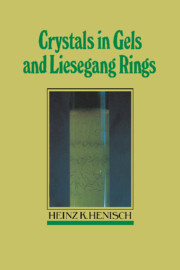4 - Nucleation
Published online by Cambridge University Press: 06 January 2010
Summary
General principles
The problem of nucleation is of crucial importance in practical operations, since the crystals which grow in any particular gel system compete with one another for solute. This competition limits their size and perfection, and it is obviously desirable to suppress nucleation until, ideally, only one crystal grows in a predetermined and convenient place. The available techniques do not, as yet, allow us to reach this level of success, though they can sometimes approach it, and sometimes achieve it by happy accident. Growth of a solitary crystal of calcium oxalate, evidently of high perfection, is illustrated in Fig. 4.1.1; see Arora (1981).
Since the application of dislocation theory to these problems (e.g. Frank, 1949, 1950, 1951a, b and Burton et al., 1951) there has been a great increase in our knowledge of the manner in which crystals continue to grow, once growth has started. In comparison, the amount of precise information on the nature of that start is still only small. Always experimentally difficult, the problem is evidently simplest in vapors and melts because only one substance is then involved. It is a priori more complex in the case of solutions because of solute-solvent surface interaction and the possibility of nuclei in the course of formation being solvent contaminated (Smakula, 1962).
Crystals growth in gels is evidently a variant of growth in solution, with additional complications arising from the presence of the gel. In this sense, gel systems do not lend themselves well to nucleation studies of the most fundamental kind. Detailed quantitative considerations, though superficially tempting, are therefore not (or, at any rate, not yet) likely to be profitable in the present context.
- Type
- Chapter
- Information
- Crystals in Gels and Liesegang Rings , pp. 89 - 115Publisher: Cambridge University PressPrint publication year: 1988

